For the second time in as many days, United Launch Alliance (ULA) has postponed its record-tying ninth Atlas launch of 2015, due to inclement weather conditions. The mission is carrying Orbital ATK’s long-awaited OA-4 Cygnus cargo mission, bound for the International Space Station (ISS). The Centennial, Colo.-based launch provider’s workhorse Atlas V—flying in its “barebones” 401 configuration, equipped with a 14-foot-diameter (4-meter) payload fairing, no strap-on boosters, and a single-engine Centaur upper stage—was initially targeted to fly from Space Launch Complex (SLC)-41 at Cape Canaveral Air Force Station, Fla., during a 30-minute “window,” extending from 5:55 through 6:25 p.m. EST Thursday, 3 December, but after going right to the wire was scrubbed and the countdown clock recycled by 24 hours, with launch expected to occur during a 30-minute period from 5:33 through 6:03 p.m.
However, although conditions on Friday, 4 December, initially seemed more favorable, excessive ground winds ultimately proved ULA’s downfall, and the mission will try to fly again Saturday at 5:10 p.m. EST.
As outlined in our AmericaSpace Photo Feature a few days ago, the satisfactory conclusion of the Launch Readiness Review (LRR) on Tuesday cleared the final hurdle prior to the quarter-mile (400-meter) rollout of the Atlas V stack from the Vertical Integration Facility (VIF) at Space Launch Complex (SLC)-41 to the pad surface yesterday (Wednesday). The rollout began a little after 10 a.m. EST and the vehicle was “hard-down” on the SLC-41 pad surface about 35 minutes later, after which it was carefully centered and propellant umbilicals and electrical and data connections were established. The track mobiles of the Mobile Launch Platform (MLP) were removed and ULA engineers prepared for formal countdown operations.
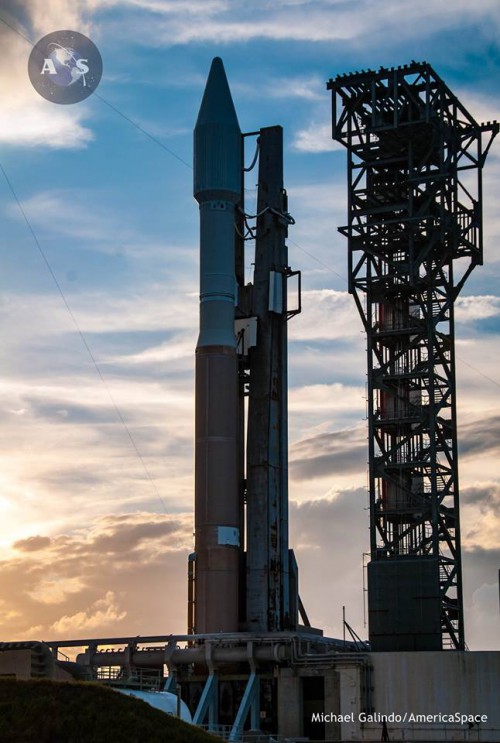
Early yesterday morning, weather conditions remained about 60-percent favorable for a launch during the 30-minute “window,” with key concerns focusing upon the presence of cumulus clouds, disturbed weather and thick clouds. “A cold (cool) front pushed into Central Florida overnight and is slowly advancing toward South Florida, where it should stall this evening,” noted the 45th Weather Squadron at Patrick Air Force Base at 9 a.m. EST Thursday. “High moisture and cloudy conditions will persist over Central Florida today and tomorrow with a threat of isolated showers behind the front.” It was added that, in the event of a 24-hour scrub to Friday, “an upper-level disturbance enhances the rainshower threat along the boundary with cloudy conditions and an isolated shower threat persisting through the day.” In addition to cumulus clouds, disturbed and thick clouds, the prospects for a Friday launch attempt were further complicated by Ground Winds, producing barely a 30-percent chance of acceptable weather conditions during the launch window.
According to AmericaSpace’s Launch Tracker, manned by Mike Barrett, countdown operations commenced shortly before midday EST at T-6 hours and 20 minutes, with the initiation of Flight Control systems. This was followed by the 3.5-hour process of bringing ground command, control and communications systems online and verifying the interfaces between the Atlas V and the Launch Control Center (LCC), including tracking capabilities and the status of the Flight Termination System (FTS). The latter would be required to destroy the vehicle in the event of a major contingency during ascent. Ahead of fueling, the booster’s propellant lines were purged and conditioned with inert gaseous nitrogen, although by 3 p.m. meteorological conditions were beginning to markedly worse, with just a 30-percent likelihood of acceptable weather during the 30-minute window.
Nevertheless, Flight Control and Communications preparations were completed briskly and by 4:00 p.m. a “Go” was received to begin chilling down and pressurizing the Atlas V’s fuel tanks, ahead of loading liquid oxygen. The first stage of the vehicle—known as the Common Core Booster (CCB)—and its Russian-built RD-180 engine are powered uphill by a combination of liquid oxygen and a highly refined form of rocket-grade kerosene, known as “RP-1.” According to AmericaSpace’s Launch Tracker, the “storable” RP-1 was loaded aboard the CCB yesterday. In the meantime, liquid oxygen began flowing into the Centaur upper stage at 4:15 p.m. and within a quarter-hour the process of conditioning the CCB fuel lines for loading was underway. This was followed by the onset of fueling the Centaur with liquid hydrogen, a little before 5 p.m. “Once this has been completed, the fueling will transition to Replenishment Mode,” explained our Launch Tracker. “This ensures that the fuel tanks remain at flight levels and any fuel that boils off is replaced.”
However, the complete absence of technical issues with the Atlas, its Centaur and the ISS-bound Cygnus payload was not mirrored by the highly dynamic Florida weather. At 4:37 p.m., with 78 minutes remaining before the opening of Thursday’s window, the weather remained “Red” (“No-Go”) and was expected to remain so for at least an hour. The cold front, which had been expected to move to the south, instead halted right over Central Florida. Weather Radar data showed virtually the entire Cape Canaveral area, together with Cocoa Beach and, further south, Melbourne and Palm Bay, enveloped in an ugly mass of ominous, rain-bearing cloud. “The Weather Launch Commit Criteria (LCC) are currently violated with a front moving through to the South of the Cape area,” noted our Launch Tracker. “This is producing disturbed weather at the launch complex, including gusting winds, rain and heavy clouds.”
As the afternoon progressed into the early evening, ULA CEO Tory Bruno tweeted: “Winds getting up there, but still ok. Red for thick clouds and DW.”
“It will be touch-and-go for Terminal Countdown starting on time,” explained our Launch Tracker at 5 p.m. “Should the weather not improve, there are five different launch times that can be utilized in the launch window.” As outlined in Wednesday’s AmericaSpace preview article, the 30-minute window is surprisingly expansive—compared to the “instantaneous” or maximum 5-10-minute windows ordinarily seen during ISS-bound rendezvous missions—and is enabled chiefly by the performance and flexibility of the Atlas V. Opening at 5:55:45 p.m. and closing at 6:25:45 p.m., the window included five discrete T-0 points, spaced 7.5 minutes apart and, as circumstances transpired, these were called into play as Thursday’s launch attempt progressed.
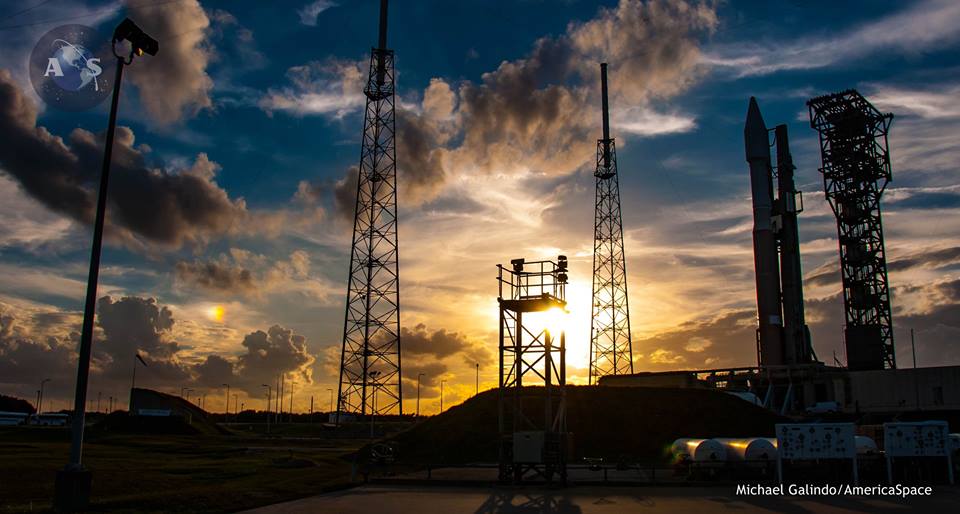
The touch-and-go nature of the weather was underlined in the moments after 5 p.m., when Launch Weather Officer Clay Flinn downgraded the forecast to just a 10-percent probability of acceptable conditions during the entire window, whilst maintaining the 30-percent likelihood that the Atlas V would fly on Friday evening, in the event of a 24-hour scrub. Flight Control preparations continued unabated, in order to ensure readiness of the vehicle in the event that the weather should co-operate and ULA could “thread the needle” through the inclement conditions. However, the somber meteorological outlook was amplified in a gloomy report from Mr. Flinn a little after 5:30 p.m. He stressed that the clouds and rain—which violated two LCC conditions, with disturbed weather and thick clouds—were likely to remain in the area until at least 7:30 p.m., at least an hour beyond the closure of Thursday’s window. “However, the count is currently continuing,” noted our Launch Tracker, “in the hopes that a hole in the clouds may appear to get the rocket off the ground.”
Entering the final pre-planned hold at T-4 minutes, it was apparent from the outset that the clock would remain stopped for longer than the normal 10 minutes. The process of transferring the OA-4 Cygnus onto internal power was put on hold and at 5:42 p.m. a revised liftoff time of 6:03:15 p.m.—the second of the five discrete T-0 points—was confirmed. Within minutes, this became untenable and at 5:50 p.m. it was again adjusted to the third T-0 point of 6:10:45 p.m. As the minutes ticked away, a final T-0 revision was set for 6:25:45 p.m., although this would occur right on the cusp of the closure of Thursday’s window, making the likelihood of a scrub almost inevitable. Since the clock would need to be released from its hold point at T-4 minutes, it was noted that an automatic scrub would occur if the countdown had not commenced by 6:21:45 p.m.
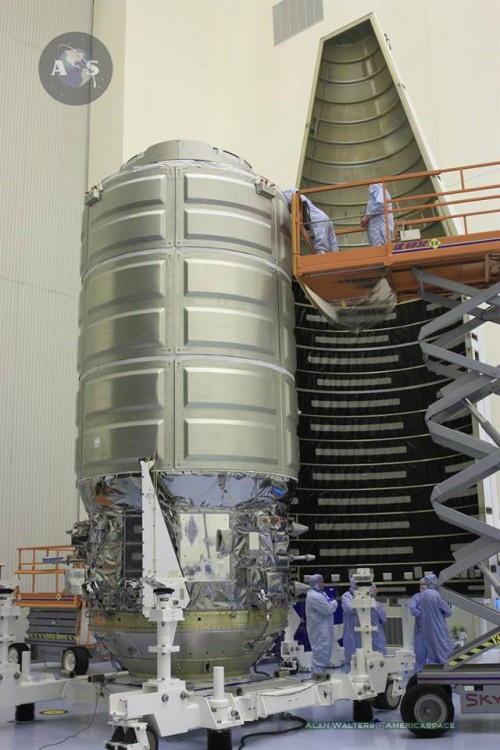
By this time, drops of rain were falling on the launch pad itself, and although concurrence was granted to begin the transfer of the OA-4 Cygnus spacecraft to internal power, it did little to affect the overall outcome of the day. At 6:12:25 p.m., after praising the professionalism and discipline of the launch control team, the Launch Director scrubbed Thursday’s attempt and efforts to remove the cryogenic propellants and position the Atlas V for a 24-hour turnaround got underway. ULA’s first mission to the ISS would again be granted the luxury of a 30-minute window, which was due to open at 5:33:11 p.m. Friday. However, from the outset, it seemed that even the second attempt would go down to the wire. “With today’s forecast of 60 percent ‘Go’ transitioning to a 0-percent chance, tomorrow is shaping up to be the same with the front a little further to the south opening up some possibilities,” stressed our Launch Tracker. “The Weather Officer still only offers a 30-percent chance of favorable conditions during the launch window.”
Notwithstanding the pessimistic outlook, launch teams entered Friday with a renewed vigor to get the Atlas V airborne. As well as marking the 60th launch by this behemoth since its maiden voyage in August 2002, and the 30th mission in its “barebones” 401 configuration—equipped with a 14-foot-diameter (4-meter) payload fairing, no strap-on boosters, and a single-engine Centaur upper stage—the OA-4 Cygnus mission would be the ninth overall Atlas V mission of 2015. This was expected to tie with 2014’s record for the greatest number of Atlas V flights executed in a single calendar year.
By 11:13 a.m. EST Friday, the countdown was underway, with flight control and ground command systems brought online and tested, ahead of of gaseous nitrogen purging and conditioning and a “Go” for fueling at shortly after 3:30 p.m. “The weather is looking a lot better than yesterday right now,” AmericaSpace’s Launch Tracker noted a few minutes later. Liquid oxygen tanking got underway at 3:41 p.m., by which time the meteorological outlook approached a 40-percent likelihood of acceptable conditions at T-0. An hour later, fueling of both the Atlas V CCB and the Centaur was complete and had entered “Replenishment Mode,” as the countdown entered the final pre-planned hold at T-4 minutes, a little past 5 p.m. During this period, the final weather briefing by Mr. Flinn was made and all stations were polled for their readiness to support the second launch attempt.
In contrast to the gloom which enshrouded yesterday’s countdown, the briefing generated a prediction of no issues with regard to cloud cover, although ground winds posed a slight concern. However, noted our Tracker at 5:06 p.m., “all conditions are Green (“Go”) at the moment and are expected to remain so throughout the window.” Those conditions—ranging from Cumulus Clouds and Attached and Detached Anvil Clouds, through Disturbed Weather and Thick Clouds to Winds—were green across the board, creating seemingly a perfect situation for an on-time liftoff. The OA-4 Cygnus spacecraft transitioned to internal power at 5:14 p.m. and the countdown passed smoothly through a final “Go/No-Go” poll of all stations at 5:26 p.m. With all controllers reporting their readiness to support today’s attempt to Launch Conductor Scott Barney, the T-4-minute hold was removed at 5:29:12 p.m. and the Terminal Countdown was initiated.
However, within seconds of resuming counting, the clock halted at T-3:09, due to an issue, and was recycled to T-4 minutes, before a revised T-0 of 5:48:12 p.m.—the third of five discrete T-0 points during the 30-minute window—was announced. “Wind exclusion. Hold. Recycling,” tweeted ULA CEO Tory Bruno in the moments after the clock halted. In readiness for hitting the revised launch time, Mr. Barney pressed for the second time through his “Go/No-Go” polls and the clock was released at T-4 minutes at 5:44:12 p.m. “Here we go,” optimistically tweeted Orbital ATK. However, again, good luck seemed not to be on ULA’s side, as the clock stopped at T-3:42, due to Ground Winds having been exceeded. Again, the countdown was recycled to T-4 minutes, pending a revised T-0 time at 6:03:12 p.m., which would occur right at the closure of Friday’s 30-minute window.
The gods of the weather were clearly on everyone’s mind, not least ULA itself. “Dear weather: Please be nice. Thx,” the company tweeted. As frustrating as the situation was, the unbending LCC requirements were obvious. “Too windy!” noted Canadian Space Agency (CSA) astronaut David Saint-Jacques in a tweet during the second hold, whilst fellow Canadian Chris Hadfield—who commanded the ISS during Expedition 35 in the spring of 2013—added: “Don’t want to blow the rocket into the launch tower structure when it’s just getting started. Launch is the hardest part of spaceflight.” Others weighed-in with their thoughts. Veteran shuttle and ISS astronaut Doug Wheelock, seated at the Capcom’s console in the Mission Control Center (MCC) at the Johnson Space Center (JSC) in Houston, Texas, remarked “Not exactly a “VIP” seat for the @OrbitalATK launch, but a seat that I treasure as part of this amazing NASA team!”
At 5:57 p.m., keenly aware that this was the final opportunity to launch on Friday, Mr. Barney pressed for the third time into a smooth “Go/No-Go” poll of all stations. Yet again, almost immediately after the clock resumed counting from T-4 minutes, another hold was called, due to excessive ground winds. Since there now existed insufficient time to run through the final 4 minutes of the Terminal Countdown and accomplish a launch before the 6:03:12 p.m. closure of the window, a scrub was unavoidable. “Mother Nature has played tricks on us once again,” was the disheartening report from NASA, although ULA noted that it would take several factors into account—including the need for adequate rest of its workforce—before a third launch attempt could be scheduled.
Be sure to “Like” AmericaSpace on Facebook and follow us on Twitter: @AmericaSpace
.
Missions » ISS » COTS » CYGNUS » ORB-4 »



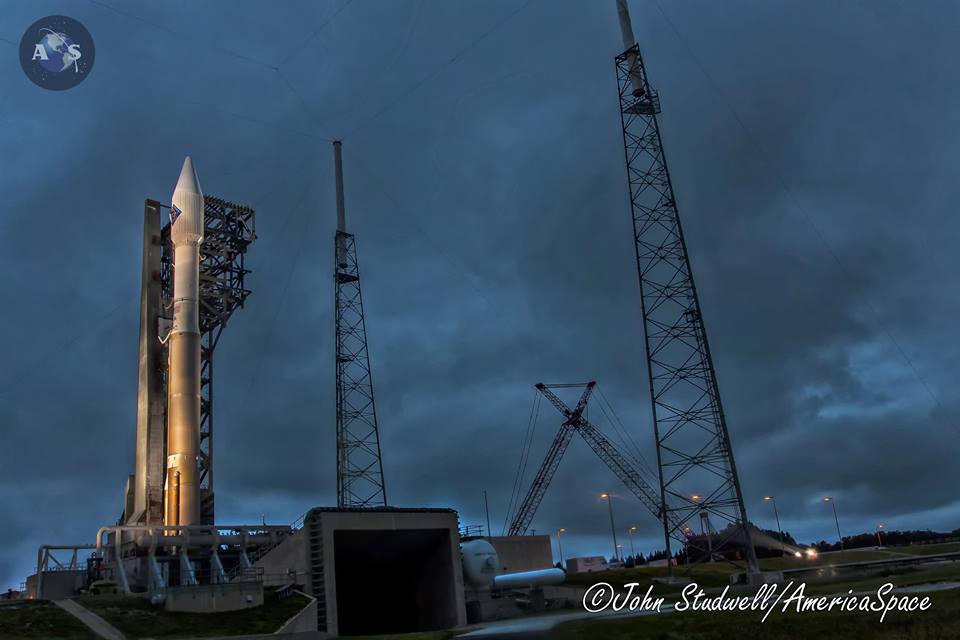
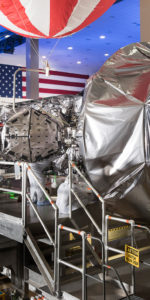

Godspeed ULA & OATK.